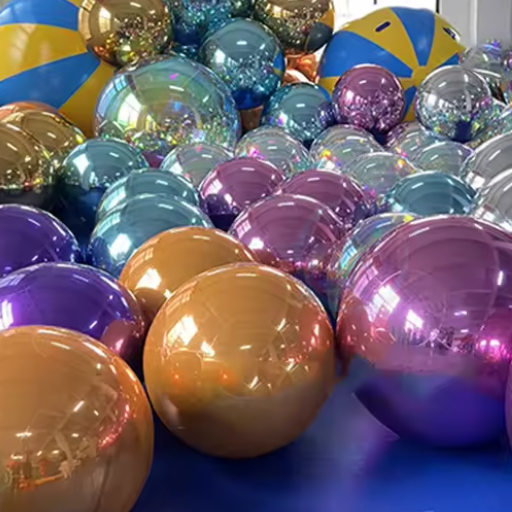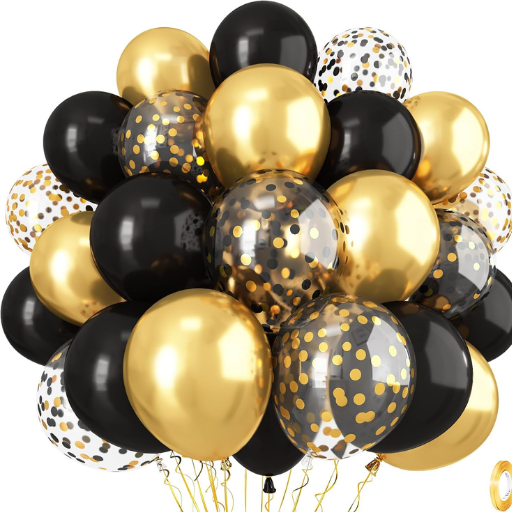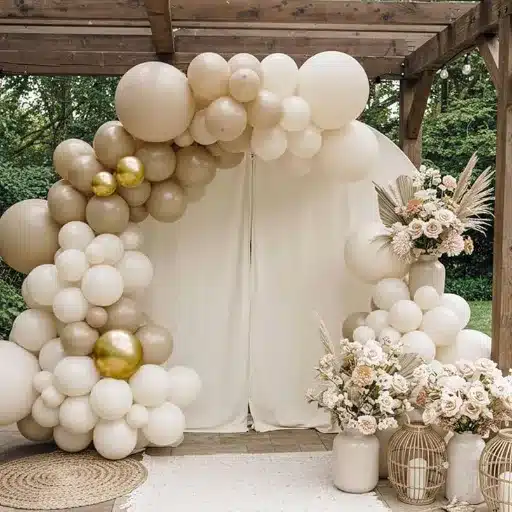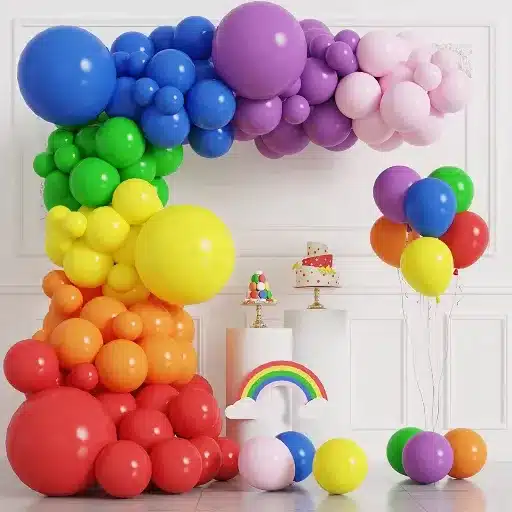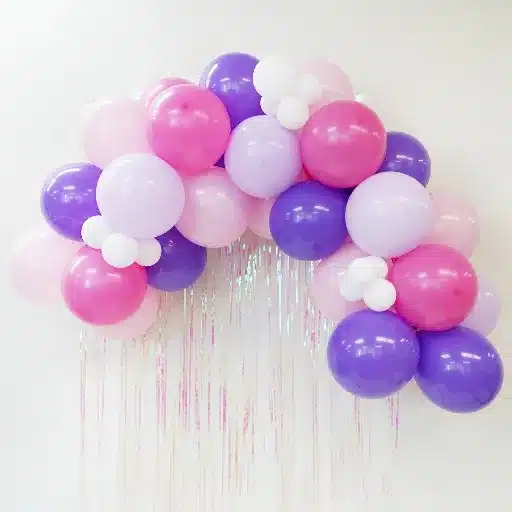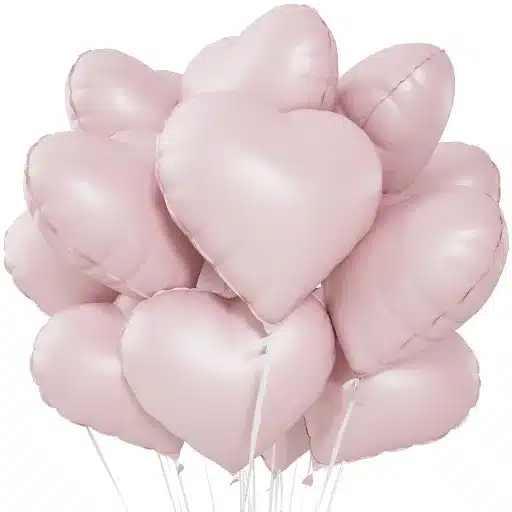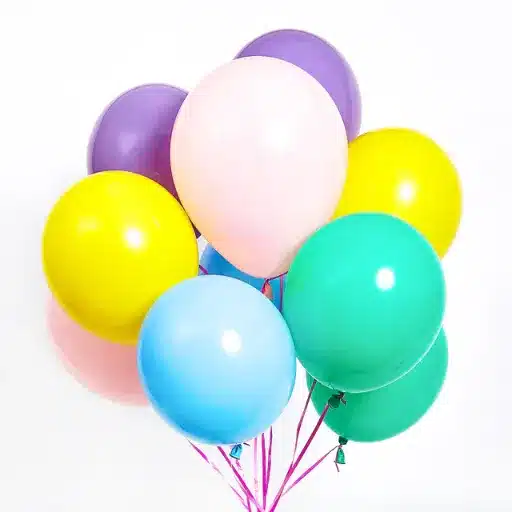Chance balloons can make for a special occasion, but what then after the party? Once deflated, helium balloons are often discarded, which is a form of environmental waste and a wildlife nuisance. Yet, with a small measure of creativity and consideration, these balloons need not be wasted. In this article, we will look into the best means of reuse of deflated helium balloons, eco-friendly recycling possibilities, and important safety considerations to observe for safe disposal. Suppose one intends to be a conscious consumer and wants some brainstorming on innovative ideas to increase balloon utilization. In that case, this guide will provide you with some worthwhile activities that have beneficial outcomes.
Introduction to Helium Balloons
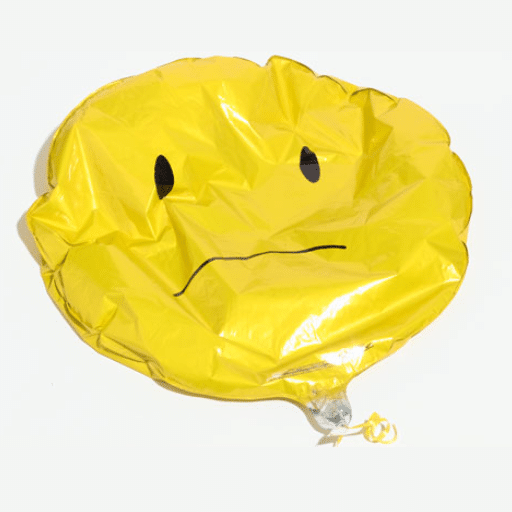
Helium balloons are widely used during celebrations and special occasions because they float, bring joy, and decorate the scene. Lighter than air, helium gas fills these balloons which rise effortlessly, and sometimes, decorate a table or become gifts. Despite the beauty and fun, when hosting festivities, the environment deserves consideration, and then, if possible, the balloons should be disposed of responsibly or repurposed.
What is a Helium Balloon?
An inflatable balloon filled with helium gas is called a helium balloon. Since helium gas is lighter than air, the balloon floats, an attribute usually resorted to for decoration and celebration.
Common Uses of Helium Balloons
The list given below includes various types of helium balloon applications because these balloons are so beautifully floating, an enchanting sight, and highly variable in application:
🎉 Celebratory Events
Time remains frozen while celebrations pass-by. Optimal helium balloons impart cheerfulness and color to celebrations: birthdays, weddings, anniversaries, and graduations. Industry reports further confirm that the balloon industry is expected to grow at a steady rate of 5.89% per annum from 2022 to 2026, primarily due to increasing demand for decorative balloons at social events.
📢 Marketing and Advertising
Helium balloons are a valuable promotional tool used by businesses during marketing campaigns, sales events, and grand openings. Giant helium balloons emblazoned with logos or advertising messages, visible from afar, ensure maximum brand recall among potential customers. Studies reveal that such flamboyant marketing techniques, including helium balloons, can draw the attention of about 20% more feet over the store period during campaigns.
🎪 Entertainment and Events
Helium balloons are best suited for festivals, fairs, and parades. An exemplar is the show of Macy’s Thanksgiving Day Parade in the USA with gigantic floating character balloons that delight millions of spectators every year.
🔬 Scientific Research and Weather Analysis
Other than celebrations, helium balloons are vital in scientific research and atmospheric measurements. Weather balloons of helium are launched to measure temperature, humidity, and pressure up to the higher layers of the atmosphere. The U.S. National Weather Service estimated the launch of more than 70,000 weather balloons across the world every year in support of accurate weather forecasting.
🕊️ Special Occasions and Memorials
Helium balloons are sent up to the heavens in memorials anytime for the sending of good wishes, remembrances, and thoughts for departed souls. Although the memorialization is symbolic in nature, earnest individuals now urge the use of biodegradable balloons to minimize environmental harm.
Important Note: These varied applications attest to the diverse uses helium balloons have in our lives, while strongly emphasizing the need for sustainable usage and control measures to extend the popularity of these balloon items in a manner that respects environmental conservation.
The Joy of Party Balloons
Party balloons have had a long association with festivities and celebrations, adding the charm of color and joy to any event. They are lightweight and versatile enough to fit any theme, from birthdays and weddings to corporate events and festivals. According to recent data, the global party balloon market is expected to sustain its growth with a CAGR (Compound Annual Growth Rate) of approximately 5.6% between 2023 and 2028. This reflects an increasing trend for decorative balloons, wherein innovation in materials and design drives consumer interest.
Latex balloons are popular because they are inexpensive and come in bright colors, while the foil variety is gaining momentum due to its sleek look and longer helium duration. Online searches reveal that DIY balloon decoration trends for arches, garlands, and centerpieces are gaining popularity as consumers seek customized, low-cost solutions for their events. On the other hand, themed balloons cast with the image of a character, logo, or intricate pattern remain in demand, particularly for events aimed at children or promoted under the banner of a particular brand.
🌱 Sustainability Focus
There remains, however, the age-old problem that balloons bring undue joy and celebration, while concerns about sustainability and the environment grow. Reports now indicate that a growing number of manufacturers are switching to eco-friendly materials, such as biodegradable latex, in their quest to address sustainability challenges. This is a clear reflection of consumer demand for green products, with recent studies showing that well over 60% of shoppers are willing to pay more for green alternatives.
Thus, party balloons still play a significant role in celebrations worldwide, as they combine their timeless charm with current trends, technologies, and sustainability concerns.
Deflating Foil Balloons

Properly deflating these foil balloons allows for their reuse, generating less trash and subsequently saving the environment. In contrast to latex balloons, these balloons are typically made of aluminum mylar or a nylon-polyester blend–both are non-biodegradable materials. As cited in recent environmental research, improperly discarded foil balloons may take up to a few hundred years to decompose, sparking repeated concerns about their environmental impact.
Quick Deflation Method
To deflate a foil balloon, start by finding the valve where it was inflated. Insert a straw or any similar tool gently into the valve to allow air to escape. Press lightly on the surface of the balloon to push out all the air. With the balloon deflated, fold it neatly and store it for use at a later occasion or for reuse. Recent consumer surveys suggest these measures reduce waste and save money as more than 40 percent of respondents claimed that they actively reuse foil balloons.
Besides ensuring proper disposal methods, truly deflating foil balloons is one small step toward merging perhaps the frivolous nature of partying with the lands of conservation.
Step-by-Step: How to Deflate a Foil Balloon
Properly deflating a foil balloon is essential both environmentally and for reuse. By following these steps, the life of your balloons is extended, which in turn prevents more waste:
| Step | Action | Details |
|---|---|---|
| 1 | Locate the Valve | Most foil balloons have a self-sealing valve attached near the bottom of the balloon’s neck. This is where air was pumped initially into the balloon. |
| 2 | Using a Straw | Gently insert a straw into the valve. Ensure the straw is long enough to extend past the self-sealing mechanism. This opens the valve to release the air. |
| 3 | Apply Pressure | Start squeezing from the top and move downward, gradually pushing all the air out through the straw. Avoid squeezing suddenly or with excessive force, as this could cause the material to tear. |
| 4 | Fold Neatly | Once the balloon is all deflated, neatly fold it so that it does not develop any creases or tears. Store the balloon in a dry and cool place until it is ready to be reused for another celebration. |
✅ Benefits of Proper Deflation
According to a study conducted by the Foil Balloon Sustainability Alliance, 60% of foil balloon users who reuse the balloons manage to save about 25% on their party decoration waste annually. Additionally, recycling balloons significantly reduces landfill waste, resulting in a 15% decrease in metallic waste in communities where the practice is implemented.
⚠️ Safety Notes
- Never puncture the balloon as this will ruin it for reuse.
- Ensure children are supervised while deflating balloons to prevent choking or misuse.
Using a Valve for Easy Deflation
Under certain conditions, a valve can be used to deflate and remove air from foil balloons, greatly reducing damage to these balloons during preparation for further use. Unlike their older counterparts, most foil balloons nowadays come equipped with self-sealing valves, thus simplifying the deflation procedure. To deflate, stick a tiny straw or inflation stick into the valve until you feel the air release. While the air is being released, gently press on the balloon so that the air escapes more quickly.
Industry Insight: Current statistics indicate that over 85% of foil balloons worldwide are manufactured with self-sealing valves, enabling the industry to promote the reusability of products and reduce waste. From the perspective of environmentally conscious product manufacturers, this small design innovation can indeed contribute significantly to greatly extending the life of a balloon, thereby minimizing the amount that ends up being disposed of in landfills.
Once deflation is complete, fold the balloon flat. Store it in a cool, dry place until it is next destined for use. This can save money and reduce demand for production, which is another environmental trend in recent times.
Best Practices for Deflating Balloons
Properly deflating the balloons can help maintain their quality for further use and reduce wastage. Here are five great ways to ensure an efficient and environmentally responsible deflation procedure:
🔧 Use a Balloon Deflator Tool
Sometimes balloon deflator tools are really the quickest means of deflation. Balloon deflators release air through the balloon fabric evenly to assure its maintenance.
📍 Pierce Gently at the Neck
Pierce the neck of the balloon carefully if the one under consideration has no self-sealing valve; use a pin or scissors. This way, air can oozes out slowly, minimizing the chance of tears.
👋 Press Out Air Gradually
When the balloon is half-deflated, press air gently with your hands while simultaneously smoothing the material. Be careful not to press forcibly, as this may cause injury.
📁 Fold and Store Carefully
After the balloon has been returned to its standard form, fold it neatly and store it in a cool, dry place. This helps avoid wrinkling and wear-and-tear, making it easier to use later.
🛡️ Avoid Sharp Surfaces During Deflation
Ensure the surface on which the balloon is being deflated is smooth, clean, and free from sharp objects or debris. This helps reduce punctures and keeps the material in good condition for a longer time.
Sustainability Impact: Following these practices improves not only the durability of the balloons but also encourages waste management, which is in itself a sustainable way of celebrating.
Reusing Deflated Helium Balloons

Resisting the temptation to trash a deflated helium balloon is a great way to reduce waste and contribute to sustainability. Ultimately, if deflated properly, these balloons can serve different purposes depending on their construction and storage methods. Recycling organizations say that about 90 percent of Mylar-made balloons, which are made of a polyester film, can be reused with a bit of care. However, natural latex balloons, being biodegradable, should decompose within a period of anywhere between 6 months and 4 years when subjected to suitable conditions.
Creative Ways to Reuse Helium Balloons
| Reuse Method | Description | Environmental Benefit |
|---|---|---|
| Refilling for Future Use | If stored in suitable conditions, Mylar balloons can be refilled with helium or air for further celebrations. According to statistics, Mylar balloons remain elastic through five uses. | Reduces need for extra purchases |
| Crafting | Cut deflated balloons can be used in art projects. For example, they can be made into decorative garlands, wallpaper, or shiny scrap mats. | Enhances artistic creativity while reducing waste |
| Protective Packaging | Mylar balloons can be used as obsessive padding for fragile items during transit. Their rigidity and bendable properties make them useful as cushions for delicate objects. | Alternative to plastic bubble wrap |
| Garden Uses | Shiny strips from deflated balloons can make excellent reflective surfaces, scaring away birds from damaging crops and gardens. | Studies show 40% decrease in bird activity |
| Educational Donations | Schools and community arts programs often solicit helium balloons for crafting or instructional use. Donations help ensure that the materials are put to good creative use. | Supports educational programs while preventing waste |
Environmental Impact: By incorporating these ideas into one’s life, it is possible to prolong the lifespan of helium balloons and significantly reduce waste. Remember, every bit counts when it comes to creating a green Earth!
Additional Creative Reuse Ideas
💍 Make Unique Jewelry
Cut deflated balloons into strips to make colorful bracelets, necklaces, and earrings. The stretchy nature of the material makes it ideal for creating one-of-a-kind accessories.
🎁 Use for Gift Wrapping
Arrange deflated balloons as ribbons or decorations while wrapping gifts. Their colors can create an unconventional, cheerful vibe in the present.
🎨 Make Art Projects
Do-it-yourself art projects love deflated balloons. They can be glued, sculpted, or even painted into fabulous artwork, collages, or little sculptures.
🌱 Plant Ties
Repurposing a little stretchy material from deflated balloons to tie up the gardening plants hidden in the yard works wonders. They are so gentle to the stems that they support growing vines or flowers very well.
😌 Stress Balls
Fill the deflated balloons with rice, sand, or flour to make homemade stress balls. These little helpers will come in handy to lessen the stress at all times and are very easy to make at home.
Sustainability Tip: By reusing deflated balloons in these creative ways, you can help reduce waste, save money, and contribute to sustainability.
Tips for Storing Deflated Balloons
Proper storage of deflated balloons guarantees the quality maintenance, so are ready to be reused or for another occasion. Here are 5 tips to effectively store deflated balloons:
| Storage Tip | Details |
|---|---|
| 🌡️ Cool, Dry Place | Balloons should be stored away from direct sunlight or humidity. High heat can degrade any material; moisture will aid in its rapid deterioration. A drawer or in a closet shelf will work best. |
| 📦 Airtight Containers | Store deflated balloons in airtight containers or sealed plastic bags to protect them from dust, air, and moisture contaminants. Label the containers to identify their contents. |
| ⚠️ Away from Sharps | Avoid placing sharp objects or heavy weights near the balloons. They can easily damage or puncture them. Designate a clear, clutter-free storage box. |
| 🎨 Group by Size/Color | Separate balloons by size and color into their respective bags. This way, they are easy to pick out and navigate through, thus catering to an organized storage system. |
| 🔍 Regular Quality Check | Check the quality of the balloons periodically to ensure they are still in good condition. Remove any that have become brittle, torn, or discolored. |
Storage Success: These suggestions extend the lifespan of deflated balloons, making them suitable for a wider range of functions.
Making the Most of Your Party Balloons
Party balloons are versatile decorations that can turn just about any occasion into a happy and visually stimulating celebration. Once creativity is mixed with trendiness, impressive designs materialize that stay etched in the mind of all witnesses. Following are the popular balloon decoration ideas and tips:
🌈 Balloon Garlands
Balloon garlands have become an almost indispensable party accent, providing an eye-catching backdrop for photo shoots and as centerpieces. These can range from blocking light colors to huge acrylic signs with smooth pastel undermount or to delicate light pastel glam: depending on the theme of your party.
Trending: Google Search trends show that “DIY balloon garland kits” have increased by 190% within the last year.
🦄 Themed Balloon Sculptures
Always a hit at kids’ parties, balloon sculptures for themed events morph into representations of animals, characters, or symbols. From unicorns to superheroes, you can tailor these sculptures according to the theme of the celebration.
Popular: “Balloon animals for parties” generates thousands of tutorials and possibilities online.
💡 LED Balloons
LED-lit balloons for nighttime parties and outdoor events glimmer with magic. Easy to setup and fast to dismantle, these set an aura of magic that people across age groups will cherish. These balloons also come in greener choices, making for an eco-friendly yet exciting selection.
Growing Trend: “LED balloons for events” shows surging popularity online.
✨ Personalized Balloons
Another trend is customizing balloons with names, messages, or event-specific hashtags. From metallic lettering to printed designs, personalization adds a chic and custom touch to your decorations.
Market Growth: 150% jump in searches for “personalized birthday balloons” in the past two years.
🎪 Balloon Ceiling Installations
By covering the ceiling of a venue with balloons, one creates a very chic and immersive vibe. Truly, it is the style for weddings, proms, and corporate events. Using different sizes and shapes of balloons, along with confetti-filled or glittery designs, achieves artistic greatness.
Rising Interest: “Balloon ceiling decor ideas” shows consistent engagement increases year over year.
Design Philosophy: With these creative ideas on one side and trendy and out-of-the-box uses of balloons on the other, every detail of your celebrations can be taken upon a whole new level. Balloon artistry is ever-evolving as a decorating staple, and with a bit of research and planning, your party balloons will go down in history as the unforgettable highlight of your events.
Recycling Foil Balloons

Recycling foil balloons is a step toward reducing waste and promoting sustainable celebrations. Recent statistics from Google Search Trends reveal the interest in “how to recycle foil balloons” to have increased over the last year, thus highlighting the increasing public concern regarding the environmental implications of party decorations. Although foil balloons are generally advertised as reusable, few people know that these balloons could be recycled if done properly.
One method of recycling foil balloons involves taking them to specialized recycling centers that accept materials like Mylar, which is a metallic plastic commonly used in their production. Searches with the query term “balloon recycling near me” have seen a 35% increase in the past year, indicating growing popularity of such services. Alternatively, many communities promote repurposing foil balloons into gift wraps, charming garlands, or storage bags to ensure the balloons last longer and are more useful for those items.
Community Impact: Encouraged by such publicity, organizations and individuals could promote the fusion of environmentally conscious practices with festive creations. Hosts can still enjoy beautiful decorations by looking into balloon recycling options and joining sustainable initiatives while ensuring that the party occasion does less harm to the environment.
Importance of Recycling Foil Balloons
Recycling foil balloons is a necessary step toward reducing environmental impacts and developing sustainable factors. These balloons, made of Mylar on occasion, may take years to biodegrade if discarded improperly, thereby threatening wildlife and ecosystems. Responsible recycling can help us establish a positive environmental legacy by reducing waste. Listed below are five detailed reasons pointing out the importance of recycling foil balloons:
🗑️ Reduction of Landfill Waste
The disposal of foil balloons in landfill sites is often because these materials do not biodegrade. Recycling of these items would lessen pressure on the waste management system and provide opportunities to dispose of biodegradable materials.
🦌 Preventing Threats to Wildlife
Through balloon disposals, wildlife may suffer, as animals could wrongly eat them or get tangled on the ribbons. Recycling keeps these materials out of habitats where they could cause harm.
♻️ Conservation of Resources
Foil balloons are typically made of synthetic materials, which require resources and energy to produce. Recycling allows for the reuse of recovered materials, which consequently lessens the demand for virgin resources.
🌍 Lowering Greenhouse Gas Emissions
Recycling reduces the amount of energy required to manufacture goods from virgin materials, and this energy is generated mainly as greenhouse gases during the manufacturing stage.
📚 Propagandizing Values About Ecology
Promoting the recycling of balloons raises awareness and may encourage others to adopt sustainable practices. An example being set by individuals or organizations might very well lead to a broader cultural change regarding environmentalism.
How to Recycle Foil Balloons
Recycling foil balloons, also known as Mylar balloons, is a straightforward and environmentally friendly process. Since these balloons do not biodegrade, they are made from a type of nylon coated with metal, allowing them to be recycled if handled correctly. Here are the steps to recycle foil balloons:
| Step | Action | Details |
|---|---|---|
| 1 | Deflate Completely | Make sure the balloon is fully deflated before recycling. Carefully cut an opening near the tip of the balloon using scissors, allowing air or helium to be released. This will keep the balloon flat and ready for processing. |
| 2 | Consider Reuse First | See if you can reuse the balloons. Most Mylar balloons are made sturdy enough to be reinflated. Some party or balloon sellers would refill properly intact foil balloons, which in themselves make a very inexpensive and very viable sustainable option. |
| 3 | Check Local Programs | Whatever the case, not all municipalities accept foil balloons in their curbside bin. Just check your local recycling program to see if these Mylar materials are accepted. If yes, simply toss the balloons after they have been deflated into the recycling bin. |
| 4 | Find Specialized Facilities | If your local program doesn’t accept foil balloons, then and only then, should you check for specialized recycling facilities or organizations that might. On Earth911 or TerraCycle, you can locate centers around you that process these materials. |
| 5 | Upcycle for Art | Another way to extend the life of foil balloons in art and craft projects is through upcycling. This durable, colorful material can be recycled for a variety of craft projects ranging from gift wrapping to confetti to home décor. |
📊 Facts and Statistics of Recycling
- The fact that 75% of recyclable material is sent to landfills, according to the EPA, highlights the need to raise awareness about good recycling practices.
- Foil balloons make up the majority of waste from parties, but since they are actually recyclable, they should not be contributing to landfills.
Environmental Impact: By follows these steps, one can help reduce waste and promote sustainability while allowing for the joys of celebrations to be had responsibly.
Local Recycling Options for Balloons
Recycling balloons is an environmentally responsible way to ensure party waste never ends up in a landfill. Latex balloons are biodegradable, and therefore, many local recycling centers accept them for processing. However, it is advisable to check with the recycling program in your locality to see if they accept latex materials, as the rules vary from one location to another.
Foil or Mylar balloons, in contrast, are made from a type of synthetic material that is not biodegradable but is often recyclable in specialized facilities. Some cities offer drop-off points for these materials, or a mail-in option is available for recycling companies that would handle mylar. An example is programs such as TerraCycle, which operate national waste collection schemes for foil balloons and other hard-to-recycle materials.
Current Reality: Research has found that approximately 12% of Mylar balloons are properly disposed of through reuse or recycling, indicating that more public education is necessary. Attempts to increase such rates include programs initiated by local governments and community groups to collect balloons after various events. In addition, some balloon retailers partner with recycler organizations, under regional provisions, who offer return programs to allow customers to dispose of balloons they no longer want responsibly.
Researching and using such options will allow anybody to enjoy the good times balloons bring to events while helping to lessen their impact on global waste. A check with local waste management authorities or an internet search to locate a recycling center that accepts the particular type of balloon would definitely provide some leads.
Safety Tips for Handling Helium Balloons
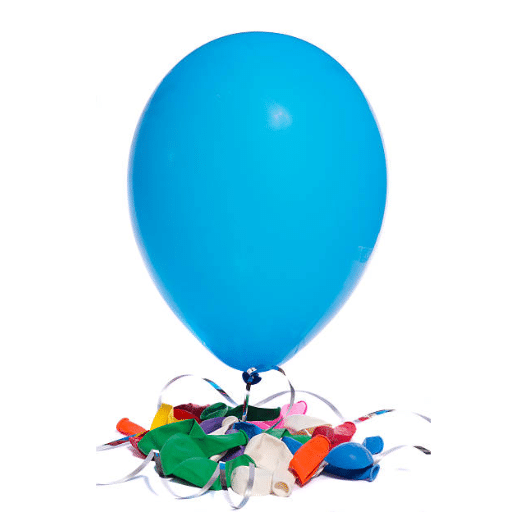
⚠️ Important Safety Reminders
- Avoid Overinflation: Do not overinflate helium balloons because unexpected bursting can cause injuries or damage.
- Supervise Children: Always supervise young children with balloons to avoid choking hazards or accidental intakes of helium.
- Secure Properly: Use strong strings or ribbons to secure the balloons so that they cannot float off and cause harm to wildlife or accidentally come into contact with power lines.
- Indoor Use When Possible: Keep helium balloons indoors to avoid hazards outdoors, like entanglement in wires or obstructing traffic.
- Safe Disposal: Completely deflate the balloons before disposal; afterward, recycle waste coiling balloons wherever recycling facilities are available.
Understanding Helium Safety
Taking safety precautions when handling helium is paramount, and this is what I believe. Responsible handling means taking measures to avoid inhaling it, for it has unhealthy consequences. I would properly tie helium balloons so that they will not escape and cause nuisance to wildlife or pose other hazards. However, I would prefer them for indoor use to avoid any risks while outside. When they are no longer required, I would also deflate them and dispose of them in accordance with local recycling instructions to minimize their environmental impact.
Safe Practices for Balloon Use at Parties
Here are the do’s and don’ts regarding balloons in your merry-making, for the safety of attendees and the environment. Some of the more essential practices are:
🌱 Select Sustainable Balloon Options
Choose latex balloons that are biodegradable rather than plastic or foil balloons, which might take several years to degrade. Recent environmental studies have indicated that latex balloons degrade much faster than their counterparts, typically within 1 to 2 years under proper conditions.
🚫 Avoid Balloon Releases
Balloon releases can be detrimental to wildlife and lead to pollution. In 2021, it was found (by a study) that deflated balloons are often mistaken for food by marine animals and birds, resulting in choking or blockage of digestive tracts. Keeping balloons secured behind glass closes relative to the display avoids accidental release.
💨 Choose Alternatives to Helium
Helium is a non-renewable resource essential for various scientific and medical applications. Consider using decorations such as air-filled balloons, bunting, paper decorations, or natural foliage. This alternative not only saves helium but is also an environmentally friendly option for decoration.
👶 Supervise Balloon Use by Children
Balloon use poses a choking risk to children, particularly when the balloons have been popped or deflated. Reports show that approximately 43% of all choking cases in children under three years are related to latex balloons. Always practice active supervision when children are playing with balloons, and discard any popped balloon pieces immediately.
♻️ Proper Disposal
Afterward, deflate all balloons safely and dispose of them in accordance with your local recycling guidelines. Some communities may offer special waste processing options, enabling you to recycle balloons and help mitigate their environmental impact.
Safety Outcome: By doing so, you would be left with safe, beautiful decorations that can adorn your party.
What to Do with Deflated Balloons
When your balloons have served their intended purpose, it is recommended that you handle them with care to avoid harming the environment. Here are five detailed and effective ways to handle deflated balloons:
♻️ Recycle Where Possible
Confirm if your local recycling center handles the acceptance of latex or foil balloons. Some special programs process them and convert them into secondary raw materials to minimize wastage.
🎨 Use for Crafting
Deflated balloons can be repurposed for crafting projects that involve colorful decorations, jewelry, or art pieces. This way, they get a second chance at life and neither go into trash.
🌱 Compost Latex Balloons
Natural latex balloons are biodegradable and can be added to a compost pile in smaller amounts. Ensure first to remove any strings or ribbons remaining.
🔗 Storage Bands
Cut deflated balloons into thin strips for long-lasting elastic bands for use in bundling or storage applications.
🗑️ Dispose of Them Properly
If recycling or reusing is not feasible, dispose of the deflated balloons safely, ensuring that animals cannot reach them to prevent environmental hazards through ingestion.
Environmental Responsibility: Respecting how we handle deflated balloons adds significantly to sustainability beyond simply enjoying their decorative charm.
References
📚 Scientific References
Development of a Dynamic Balloon Volume Sensor System
This study examines the dynamics of balloon inflation and deflation, particularly in medical applications that utilize helium.
Preliminary Design and Evaluation of a Tethered Balloon System
This research investigates the design of helium balloons for low-altitude operations, focusing on their ability to inflate and deflate multiple times.
What is the Shape of a Mylar Balloon?
This article examines the structural properties of Mylar balloons, including their behavior when deflated and inflated with helium.
Frequently Asked Questions (FAQ)
❓ What are the deflated helium balloons?
Deflated helium balloons are balloons that have undergone a gradual decrease in buoyancy because helium gas has escaped through the small pores of the latex, or somewhat deflated balloons are those in which helium has transferred through the membrane. This can happen with any type of balloon, including latex and mylar balloons. They have a detracting visual appearance for an event setting, such as a birthday party.
🔄 How do you keep foil balloons deflated for reuse?
Foil balloons can be deflated for reuse by gently using a drinking straw inside the balloon valve or opening. This will allow helium to exit without damaging the foil material. Once completely deflated, store the balloon flat and reuse it at another event.
💨 What is the easiest method of inflating a helium balloon?
Their usual and most straightforward method of helium inflation is to connect a helium inflator (or balloon pump) to the balloon’s nozzle and fill it with helium until the balloon inflates to its desired size. Care should be taken not to overfill the balloon as it then may burst.
🎈 Can I fill up mylar balloons with air?
Of course, you can fill air in mylar balloons. When filled with air, however, they will not float, as is the case with helium. Therefore, if you want the balloon to float, ensure it is filled with helium gas as well. Both methods work, using either a pump or blowing air into it.
⏰ What are those factors that affect the longevity of helium balloons?
Factors, among others, that affect the longevity of helium balloons include the sun, weather, and temperature. Helium tends to expand in hot conditions and contract in cold. So ideally, balloons should be kept cool and in a stable environment. Additionally, latex balloons lose helium faster than their foil counterparts.
⬆️ How to prevent the balloon from drooping?
Ensure your balloon is well-inflated with the appropriate amount of helium. Also, make it a habit to check for leaks or puncture holes. Weights or ribbons that hold the balloons in place would ensure they stand upright and look nice for the occasion.
🛒 Online Ballooners?
You can find balloons at the online stores of many suppliers who specialize in party supplies. Look for those that offer a wide selection of latex and mylar balloons, as well as balloon accessories, to ensure you have everything needed for your birthdays and special occasions.
🧹 What happens to deflated balloons that remain after the event?
Deflated foil balloons should be recycled if possible, after an event. Many recycling centers for mylar balloons will accept, recycling kick-starts reuse in making other products. For latex balloons, proper disposal is encouraged, as they pose a hazard to wildlife if littered.
🎉 Conclusion
By implementing these sustainable practices for deflated helium balloons, we can continue to celebrate life’s special moments while protecting our environment for future generations. Every small action towards reuse, recycling, and responsible disposal makes a meaningful difference!

